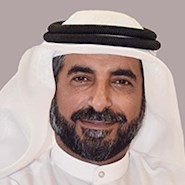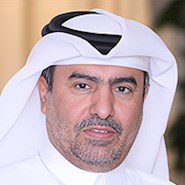By Nasser Al-Nuaimi, Ph.D., and Hilal Al-Kuwari
Qatar made sporting history in 2010 by becoming the first Arab and Middle Eastern country to be granted the right to host the FIFA World Cup. A peninsular Arab nation with a population of around 2.65 million, Qatar has a colorful and fascinating sporting history.
For the event, held in November and December 2022, seven new stadiums were built — Al Janoub, Lusail, Al Bayt, Stadium 974, Al Thumama, Ahmad Bin Ali, and Education City — and one — Khalifa International Stadium — was extensively redeveloped. An in-depth look at the Al Janoub and Lusail stadiums is available in the “World Class” feature in the November/December 2023 print issue of Civil Engineering magazine, published online as "World Cup Qatar stadiums inspired by Middle East aesthetic." A snapshot look at the other six stadiums is available below.
As recounted in Matthias Krug’s Journeys on a Football Carpet: Qatar’s Remarkable Rise in the World of Football (2019), in 1948, when oil companies began commercial work in Qatar, the foreign staffers brought their games with them to the region. At first, soccer — or football, as it is called in Qatar — was played only by oil company workers. Then Qataris occasionally joined in matches. Eventually, the sport began to spread to Qatari residential areas, or “furjan.” In 1950, Al Najah (modern day Al Ahli) was formed, becoming Qatar’s first football club. In 1963, the Qatar Football Association became a member of FIFA. Of note, Qatar’s first official league competition was launched in the 1963-64 season — the same year the well-known German Bundesliga was officially launched.
Only 10 years after Qatar received its independence in 1971 and with a total population of about 220,000, the country qualified for the 1981 FIFA World Youth Championship in Australia. Under Brazilian coach Evaristo de Macedo, Qatar beat Poland, Brazil, and England, reaching the final before eventually losing to the favorite, West Germany.
In 1973, the legendary Pelé, a three-time World Cup winner, played an exhibition game with Brazilian club Santos Futebol Clube against Al Ahli, reportedly receiving the first yellow card of his career in his team’s 3-0 win. The game was played at Doha Stadium, which was also the venue of an exhibition boxing match featuring the famed Muhammad Ali in 1971, according to Krug.
With the passion for football ever increasing in the country, Qatar built a new national stadium in time for the 1976 Gulf Cup, which it was hosting. This venue, Khalifa International Stadium, with seating of about 20,000, was massive compared with its predecessor, Doha Stadium, and was the transformative new home Qatar needed to pursue the hosting of large sporting events.
In preparation for the 2006 Doha Asian Games, a major upgrade was undertaken in Khalifa International Stadium in Al Rayyan, about 9 km west of the center of Doha, to increase its capacity to 40,000 spectators. The west stand of the stadium got a new high-tensile shading structure with a lighting arch erected over the opposing east stand to provide visual and symmetrical balance for the roof's curved lines. Other renovations included adding screens at either end of the stadium as well as VIP and corporate lounges and new athlete, media, and administrative facilities.
FIFA World Cup Qatar 2022
In 2014, the existing Khalifa International Stadium was redeveloped again in preparation for the FIFA World Cup Qatar 2022. While the stadium already had a capacity of 40,000, sightline studies established that a significant number of seats did not meet the FIFA technical guidelines of a 190 m maximum sighting distance from the furthest corner of the field. In addition, other FIFA requirements, including on-field advertising boards, hospitality lounges, handicapped facilities, spectator facilities, and camera locations, had to be taken into account. An expansion to the existing stadium was therefore necessary.
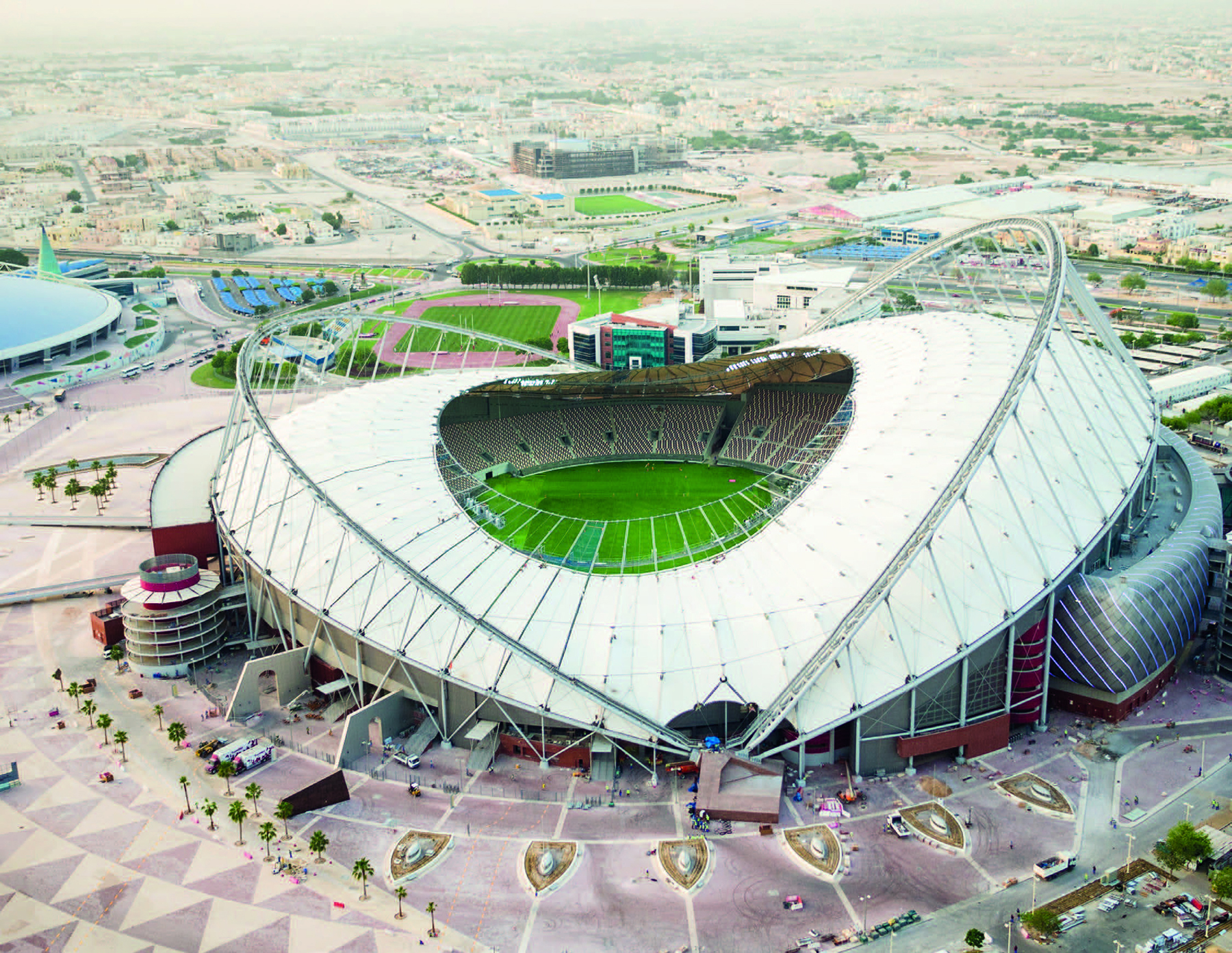
The total expansion brought the capacity to 41,000 FIFA-compliant seats. This was achieved by adding seating capacity into the east stand’s lower and upper bowls. The existing roof was replaced to cover the additional seating, meet the updated stadium’s mechanical needs, and maintain the holistic image of the stadium.
The geometry and spatial location of the covering for the stands was analyzed in detail, including with computational fluid dynamic simulations and wind tunnel testing. The covering was configured in combination with a comprehensive air conditioning system to create the optimum solar shading conditions for spectators and players and to block wind gusting that could reduce the cooling effects of the air conditioning within the seating.
The stadium was air-conditioned using jets mounted on the upper and lower bowls with the location guided by the modeling and the existing space constraints. To mitigate wind effects on the air conditioning system, especially for the open-air playing field, strategically located air cannons supply high-speed jets to temper any winds reaching the bleachers or playing field. The air cannons are operated opposite to the wind direction to protect the bleacher occupant zone from any infiltrating hot air. Additionally, any wind reaching the playing field is essentially tempered due to the significant mixing with the cold air supplied from the cannons.
Al Bayt Stadium
Al Bayt Stadium in the coastal city of Al Khor, about 50 km north of Doha, is designed to host 60,000 spectators. It hosted the World Cup opening ceremony along with several knockout matches and one semifinal. The stadium was built to resemble a traditional Bedouin tent.
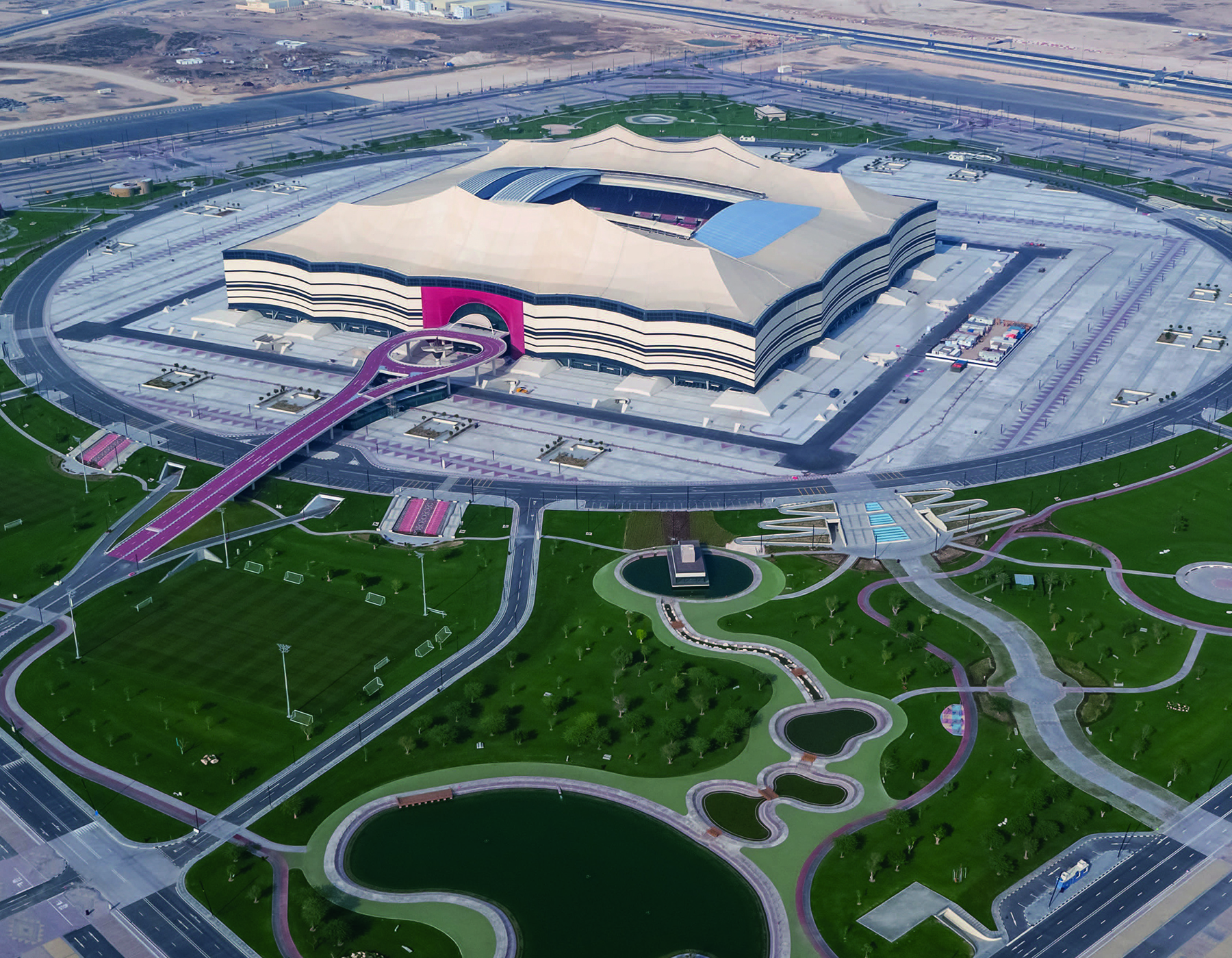
“Bayt” in Arabic means home, and the name Al Bayt is derived from the Arabic “bayt al sha’ar” — a term for the historic Bedouin tents of the nomads in Qatar and the Gulf region. The traditional tents consist of a simple wooden support structure with ropes with inner and outer covers made of woven fabrics. While the outer fabrics usually have simple horizontal stripes in beige, brown, or black, the inner fabric lining has intricate traditional patterns mostly in black, red, orange, and white — locally known as “Sadu.” The Sadu patterns, which symbolize the traditional local culture and values, are used today as wall and ceiling decorations in the living and reception rooms of many Qatari houses.
The roof and facade support structure of Al Bayt Stadium consists of a steel truss with 72 radial lattice girders that cantilever up to 62 m above the stands. The geometry of the supporting structure is developed in such a way that a large Bedouin tent is created in the contour, in a fitting tribute to the traditional dwellings. The roof as well as the facade is covered with a polytetrafluoroethylene-coated glass fiber membrane. For the inner lining, an aesthetically important aspect for the design was to get a distinct textile appearance based on traditional fabrics. This was challenging for a number of reasons, including high temperatures, high humidity, fire requirements, and acoustic requirements, to name but a few.
Following a meticulous material study, a specially woven membrane made of color-coated single threads with a striking textile character, including high durability and color stability, was developed for the inner lining. The material and surface properties gave the membrane good acoustic properties, so that the reverberation time in the stadium could be maintained without additional measures. Appropriate antibacterial and fire-retardant additives were employed. To obtain the Sadu pattern, four different colors of the PVC-coated threads were fed into a modified Jacquard loom that made it possible to produce industrially woven fabrics with complex patterns that could be repeated as often as desired. Strength and stiffness testing was conducted on the woven material and the weld seams to verify the mechanical behavior under uniaxial and biaxial loading at different loading orientations.
Al Bayt Stadium, which reflects an extraordinary feat of ingenuity and engineering skill, without a doubt pushed the boundaries of what could be achieved in stadium design and construction.
Stadium 974
Stadium 974 is on the shore of Doha Bay. With its net capacity of 40,000 spectators, it is the first fully demountable, transportable, and reusable stadium of its kind.
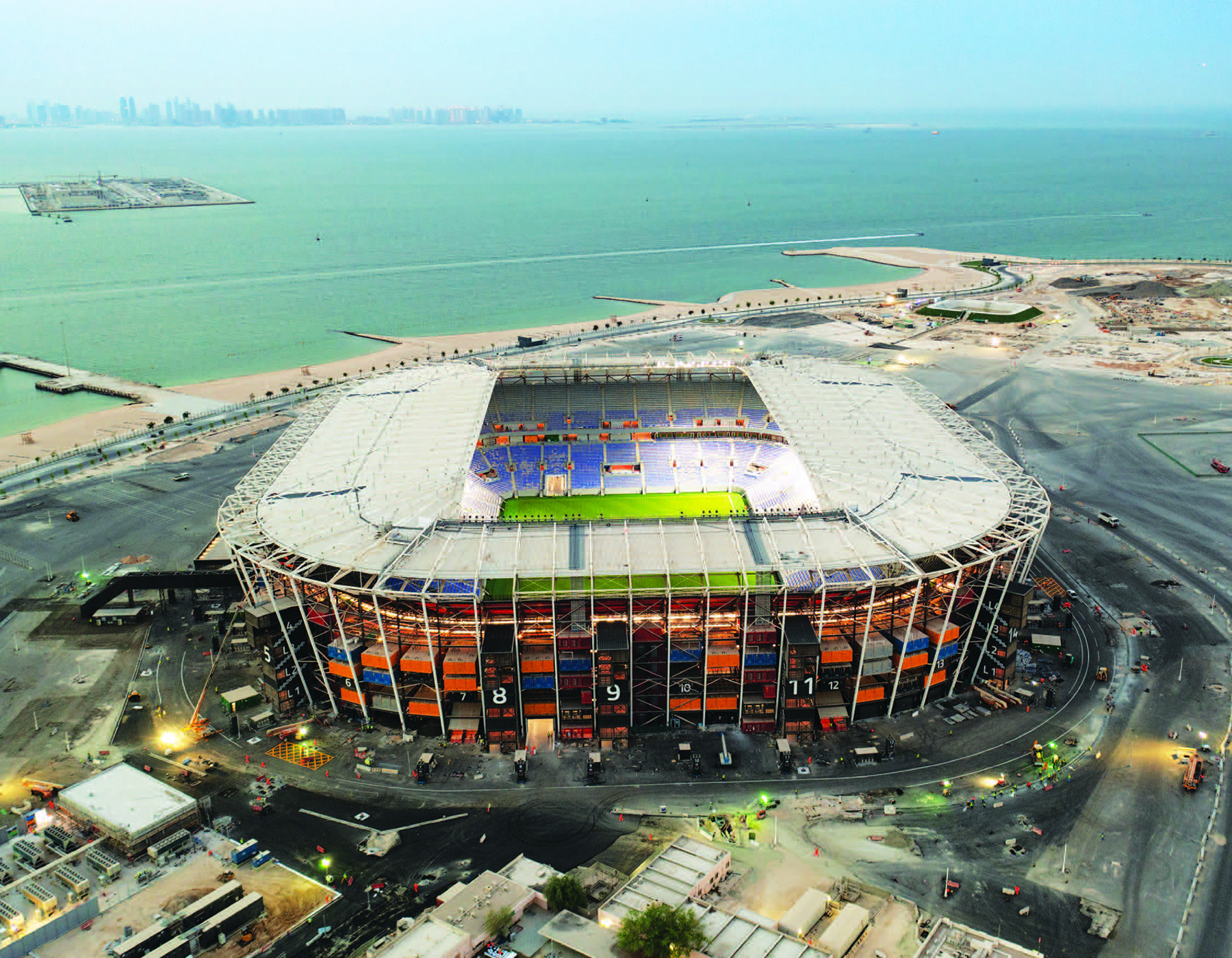
The innovative concept of this stadium is based on a simple principle: to create a temporary venue that is fully fabricated off-site; easily transported to, installed at, and demounted from the site; and completely reusable for other locations, either as one or multiple venues. To achieve this, the principles of modular construction are implemented in a highly repetitive grid of identical structural frames, supporting standardized components: bleachers, concourse slabs, and containers that are pre-equipped with all required functions. All the elements of the structure are designed to fit inside standard shipping containers so that they can be packed and transported as a complete system for the next event.
The stadium occupies an area of 212 m by 200 m in plan and at full size reaches a maximum height of 46.9 m above ground level. The structure of the bowl and roof is divided into eight sectors: four straight sectors and four corner sectors, separated by expansion joints.
Because all the connections were designed and specified to be fully demountable, they avoid plastic deformation. Every structural element of the bowl (i.e., columns, beams, diagonal bracing, modular slabs, raker beams, and bleachers) has been conceived to be transported, and as such, the elements longer than 12 m required a series of bolted splices to ensure they could fit within a standard shipping container.
The analysis of the main structure was performed by means of independent models for the different sectors. To provide maximum flexibility after the World Cup, each sector was designed to work completely independently from the others. 3D finite element modeling was used for the analyse, not only for the final configuration of the structure in service but also for the full staged construction.
The fabrication of the steel structure was performed completely off-site in a workshop in Vietnam before being shipped. Careful workshop planning was required to ensure a proper and smooth installation on-site. The pinned connections imposed tight 3 mm tolerances, requiring a trial assembly of large segments of the bowl frame and roof segments at the workshop before shipment to site. To account for any potential temperature-induced swelling or shrinking due to possible differences in fabrication and installation conditions, additional connections allowing for installation adjustments were provided in the bowl frame and roof by means of head plate bolted connections.
Al Thumama Stadium
Al Thumama Stadium, the World Cup venue designed by Qatari architect Ibrahim Al Jaidah, is inspired by a traditional woven cap worn by boys and men in the Middle East known as a “gahfiya.” The stadium is in the southern Al Thumama district of Doha, near Hamad International Airport. The district derives its name from a perennial grass known locally as “thumam” that grows abundantly in the area.
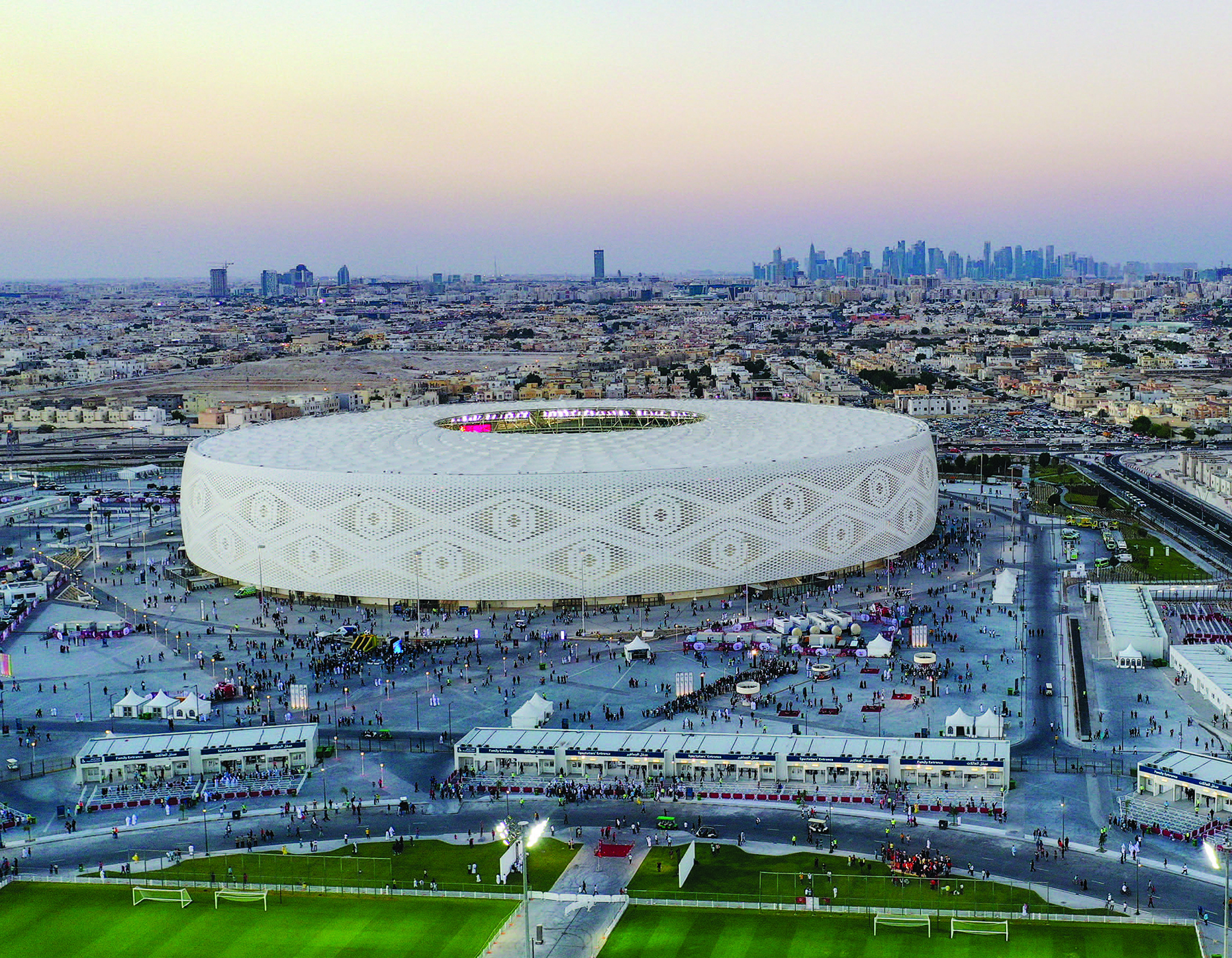
This 40,000-seat stadium hosted World Cup matches through to the quarterfinals in what is referred to as tournament mode. After the tournament, in what is referred to as legacy mode, Al Thumama Stadium’s seating capacity was to be reduced to 20,000. The structure of the stadium is subdivided into several components, including a reinforced-concrete bowl, a demountable upper-tier structure, a roof, and a facade structure.
The stadium roof is circular and covers an area of around 35,000 sq m. Its outer diameter is 230 m, and the oculus opening over the pitch measures 88 m, resulting in large radial roof spans of approximately 70 m. The roof is a spoked wheel structure characterized by three circular primary rings — upper and lower inner tension rings are connected by 40 radial trusses to an outer compression ring.
Ahmad Bin Ali Stadium
Ahmad Bin Ali Stadium, which was officially inaugurated on Dec. 18, 2020, when it hosted the Emir Cup final, belongs to Al-Rayyan City football club and is 20 km west of Doha. Built on the edge of the desert, the stadium acts as a landmark for those arriving in or leaving the city, and hence its design was inspired by its location. Around the stadium are numerous curved concession stands that take their forms directly from the sand dunes in the adjacent desert.
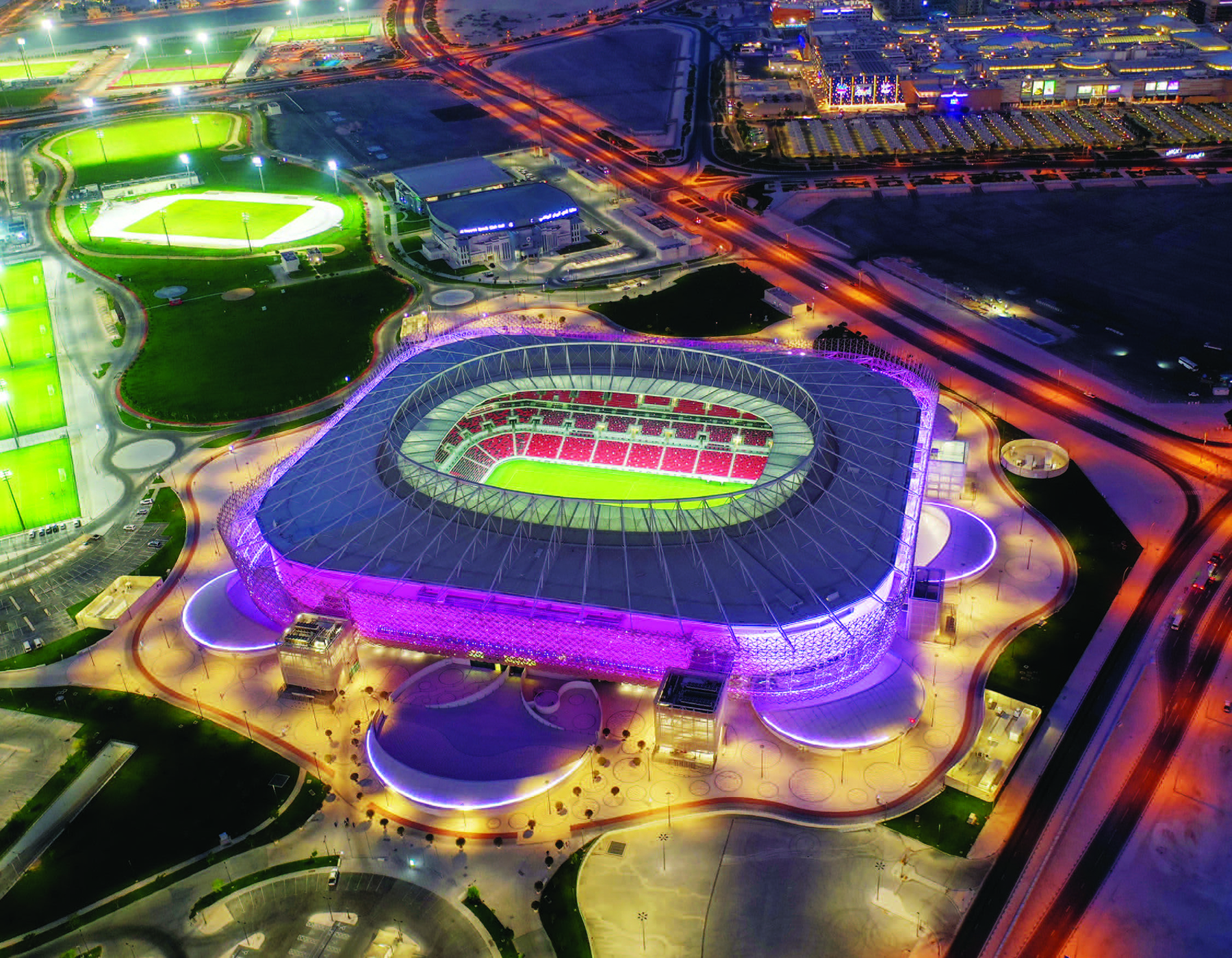
The former stadium at the site, Al-Rayyan Stadium, was built in 2003 with a seating capacity of approximately 21,000 and served as home for Al-Rayyan's football team. In 2014, the decision was made to increase the seating capacity to 40,000 in tournament mode to prepare the stadium for the World Cup. Considering the need for improved facilities and the increased capacity, this required a complete reconstruction of the stadium. Existing materials were reused as much as possible. After the World Cup, when the stadium is in legacy mode, capacity was to be reduced again to 21,000 by dismantling the modular upper-tier structure.
Education City Stadium
The diamond-shaped Education City Stadium, nicknamed “the diamond in the desert,” is set to become the home of the national women's team.
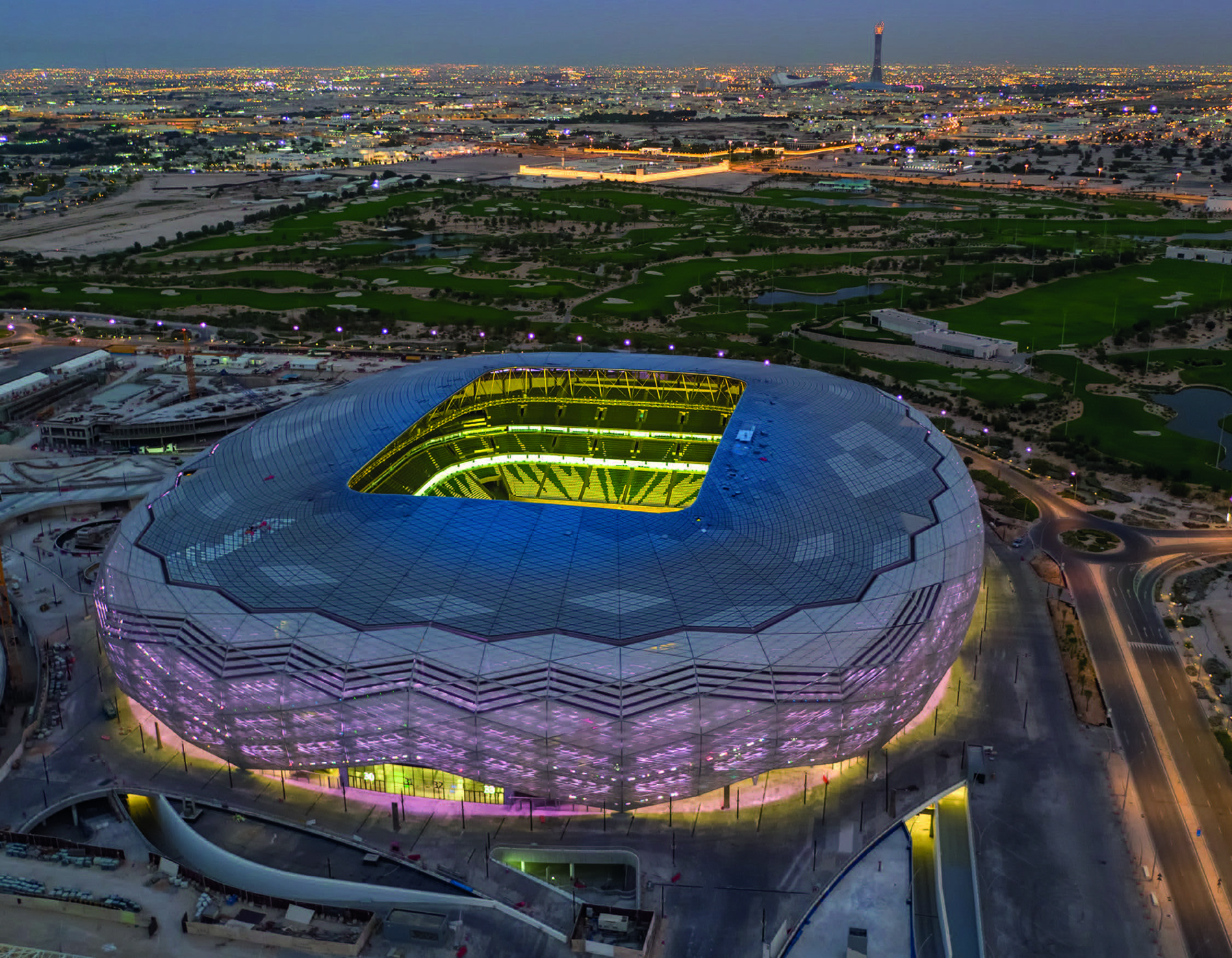
Holding 45,350 people, this spectacular venue staged group games through to the quarterfinals during the World Cup. The stadium was officially opened in June 2020 and hosted the final of the FIFA Club World Championship. The design includes an efficient cable net roof aligned with the structural imperative to reduce material use and, therefore, embodied carbon. This design helped meet the Qatari government’s Supreme Committee for Delivery and Legacy (established for the project and tournament) target of a five-star Global Sustainability Assessment System rating.
One of the key stories around the engineering design of the Education City Stadium is the balance between the decision to dig down into the ground to create a basement and reduce the overall height of the stadium while designing that basement to resist uplifting from the existing high water table as well as any future water table rise. Getting that balance right was a key part of delivering a successful stadium.
For much of the stadium footprint, the weight of the stadium itself on the raft slab was sufficient to resist design uplift forces. However, under the lower tier and outside the footprint of the stadium, the weight alone was not sufficient to resist the design uplift case. As a result, where possible, the slab was increased in thickness to increase its weight and minimize the areas requiring additional measures.
In addition, below the lower tier where vertical space was limited, tension piles were introduced to resist uplift forces. The design team also decided that the slab under the stadium needed to be of single continuous construction because including joints would have introduced the risk of water ingress. Careful studies of the stresses and deformations generated by shrinkage and thermal actions in the slab were carried out and were often the governing factor with regard to reinforcement density within the slab.
The stadium includes a basement below the playing field. Where the retaining walls for this basement level bear into the rock, a lateral restraint is provided for the structure in an outward direction toward the rock face, however the structure is free to move away from the rock. The retaining wall is locked into the rock with a mass concrete fill to provide a stiff restraint to movement, whereas its outer perimeter has a softer granular fill, allowing movement with less restraint stiffness.
The movement joint to the pavilion means that the east side of the stadium has free movement both outward and inward. The different restraint conditions on the east and west sides lead to a significant asymmetric response of the raft (and therefore the building as a whole) under heating expansion. Under shrinkage and cooling the behavior is more symmetric as the raft shrinks in toward the playing field and away from the outer perimeter all the way around the building.
Bringing it all together
Previously, the World Cup had been held across multiple host cities, which could be hundreds, if not thousands, of kilometers apart. Qatar, in contrast, hosted all 64 matches in one compact area for the first time in history — with only 55 km between the two most distant stadiums and less than 10 km between the closest.
Nasser Al-Nuaimi, Ph.D., is the associate vice president for research and graduate studies at Qatar University. Hilal Al-Kuwari, who passed away shortly after finishing his portion of the manuscript, was the technical director for the 2022 World Cup stadiums and the Qatar Supreme Committee for Delivery and Legacy.
You can read about the final two stadiums built for the FIFA World Cup Qatar 2022 in the authors’ feature, “World Cup Qatar stadiums inspired by Middle East aesthetic.”
This article is published by Civil Engineering Online.



